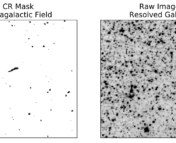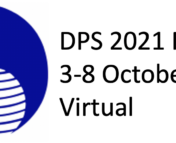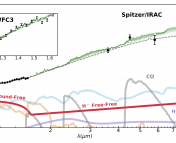Title: Hubble Asteroid Hunter. I. Identifying asteroid trails in Hubble Space Telescope images
Authors: Sandor Kurk + 13 others
First Author’s Institution: European Space Research and Technology Centre (ESA), Keplerlaan 1, 2201 AZ Noordwijk, The Netherlands
Status: Published in A&A [open access]
Strong Motivations for Small Targets
Though none of them were around to see it, astronomers are pretty confident that the early days of the solar system’s life were chaotic and violent. Scores of newly formed asteroids, planetesimals, and a few bona fide giant planets were all buzzing around the sun in a tightly packed disk: Collisions were inevitable, though their aftermaths varied. Sometimes two clumsy objects would merge together, and sometimes one or both would shatter into smaller pieces.
To get a handle on just how lawless this epoch of our history was, astronomers would love to perform a forensic analysis on the asteroids that survived to the comparatively quiescent present; if they could measure the current ratio of smaller asteroids to larger ones, they could constrain how common destructive collisions were in the past. This in turn would inform models of where objects were and how fast they moved in the early days around the sun.
Unfortunately, the most valuable asteroids for such a study –the very smallest remains– are also the hardest to find. We can only see asteroids when they reflect some sunlight back towards the earth, and small rocks just don’t reflect much light, making them very faint.
Enter the Hubble Space Telescope. Hubble is a very capable, very busy space-based telescope that is able to see these dim asteroid remnants. However, although Hubble is able to image solar system objects, it spends most of its time gazing much further afield, staring longingly at distant galaxies, quasars, and other targets at cosmic distances.
But, sometimes would-be asteroid hunters get lucky, and even when Hubble is trying to measure something else, a local space rock serendipitously wanders into the field of view. Since both the asteroid and the earth are moving around the sun, the photobombing asteroid appears as a curved streak in the image, a hairline fracture in the otherwise dark background of the universe.

Today’s authors aimed to wring as much information as possible out of these happy coincidences, and ambitiously sought to search the entire archive of relevant Hubble images for fortuitous streaks caused by covert, small asteroids .
Citizen Science + Deep Learning
Every picture Hubble takes eventually becomes public, freely downloadable to anyone who wants to see some corner of the universe. The archive of these images is immense, containing more than 37,000 images taken with the instruments and filters the authors deemed most likely to catch their targets. The scale of the database necessitates automation, and to meet this need the authors turned to deep learning, specifically Google’s Cloud AutoML Vision model. When fed an image, this algorithm reports back what’s in the picture (in this case, an asteroid, while in others, a dog for example). While they don’t detail the specifics of the architecture in this article, they share that the model consists of several interwoven machine learning components: they use a convolutional neural network to actually find the asteroid arcs in the images, but that network was itself designed by a reinforcement learning algorithm, an artificial intelligence paradigm that trains a computer to find an optimal solution via trial and error and feedback from its own actions.
Such a machine learning model needs to be trained, and training requires a catalog of known examples for the model to study. Since such a catalog didn’t yet exist, the authors had to build their own, and to do so they enlisted the help of citizen scientists. They set up a project on Zooniverse called Hubble Asteroid Hunter, and over about a year more than 11,000 volunteers logged on to comb through the data and search for asteroid arcs by eye. Each volunteer was shown several Hubble pictures, asked “Is there an asteroid in this image?” for each one, then prompted to dismiss images with no streaks and flag pictures that contained the telltale curves. These volunteers collectively submitted more than 2 million yes/no answers to the query, and in total this tremendous effort uncovered asteroid streaks in about 1% of all images.
Model Performance
After processing all of the public’s carefully labeled images and feeding them to their model, the authors unleashed their code on the full data set. How did it do? In the end, the algorithm achieved 73.6% precision (meaning 73.6% of its identifications were correct) and 58.2% recall (meaning it successfully recovered 58.2% of all the asteroids found by volunteers). While that might sound slightly subpar, it was more than enough to make some new scientific discoveries.
Combining the trails found by volunteers and those found by the model, the authors assembled a pile of 2,487 possible asteroid arcs. They then went through each of these candidates manually, and after removing duplicates and accounting for false positives caused by cosmic rays, gravitational lenses, or earth-bound satellites, they culled the list down to 1,701 confident asteroid detections.

After checking if any of these streaks could be attributed to any of the more than 1.2 million known asteroids, the authors concluded that 670 of the streaks corresponded to previously discovered sources and that the remaining 1,031 were caused by never-before-seen asteroids. They also found that these freshly discovered asteroids were systematically fainter than the known bodies, which they expected: the brighter an asteroid is, the higher the chance that it was already detected by a ground-based survey. This general faintness also hinted that many of their new discoveries are exactly the type of small asteroid which we’ve struggled to count in other surveys.
The authors also start to explore other properties of their sample of new asteroids, including their spatial distribution and brightness variability. Though they do not account for the biases of Hubble’s preferential pointing and leave much of this further analysis for future work, their presentation of this new sample and demonstration of the power of merging citizen science and machine learning is an exciting step forward in the small-asteroid accounting business. The more confidently we can count the small asteroids, the closer we can come to understanding our solar system’s early history: now, if more drift into our view, we’ll be ready for them.
Astrobite edited by Ryan Golant
Featured image credit: ESA/Hubble & NASA, M. Thévenot (@AstroMelina); CC BY 4.0




